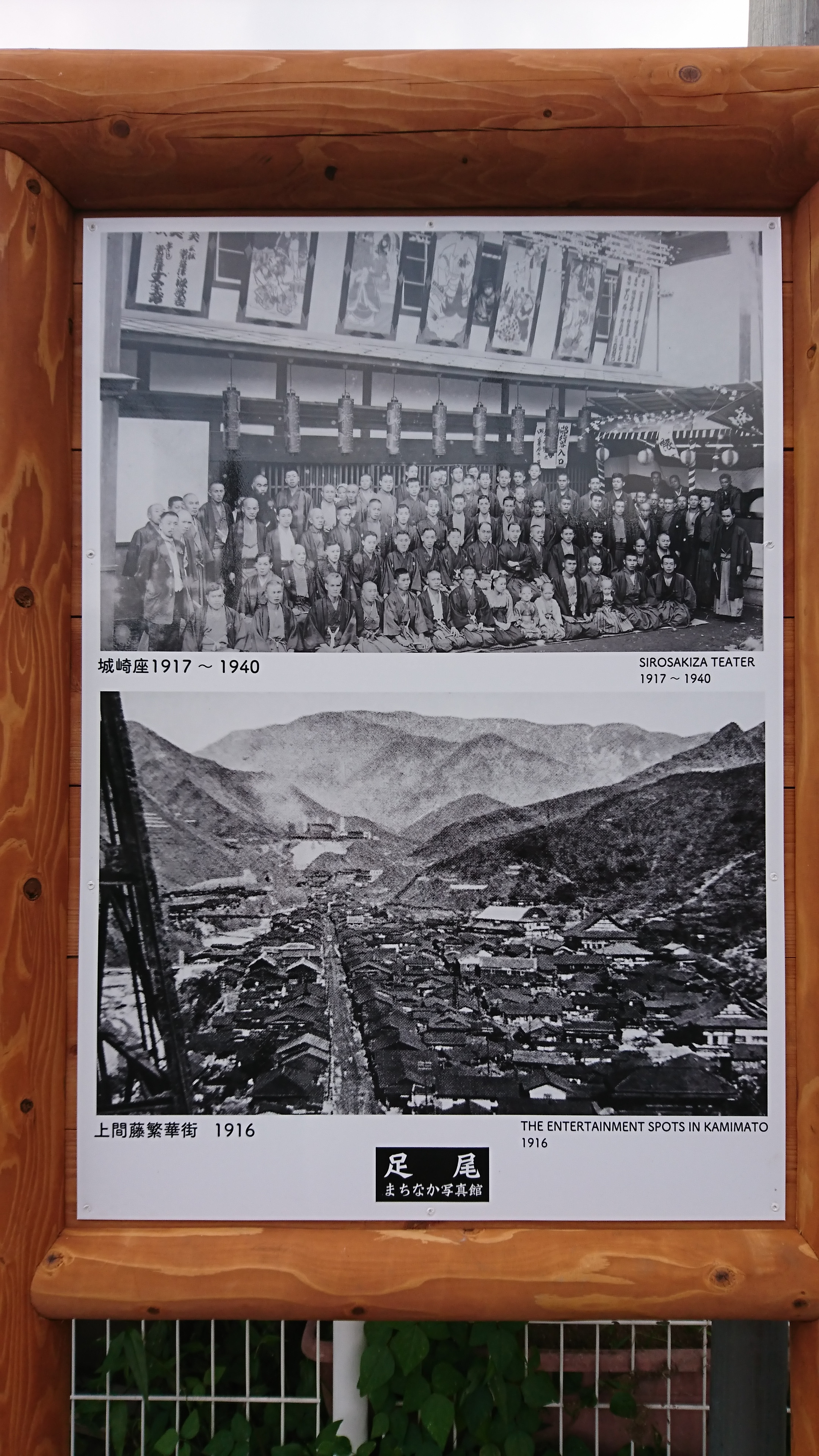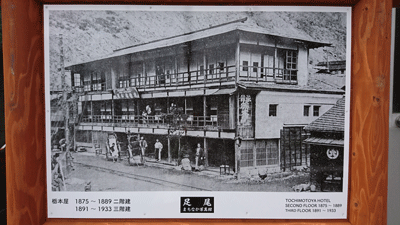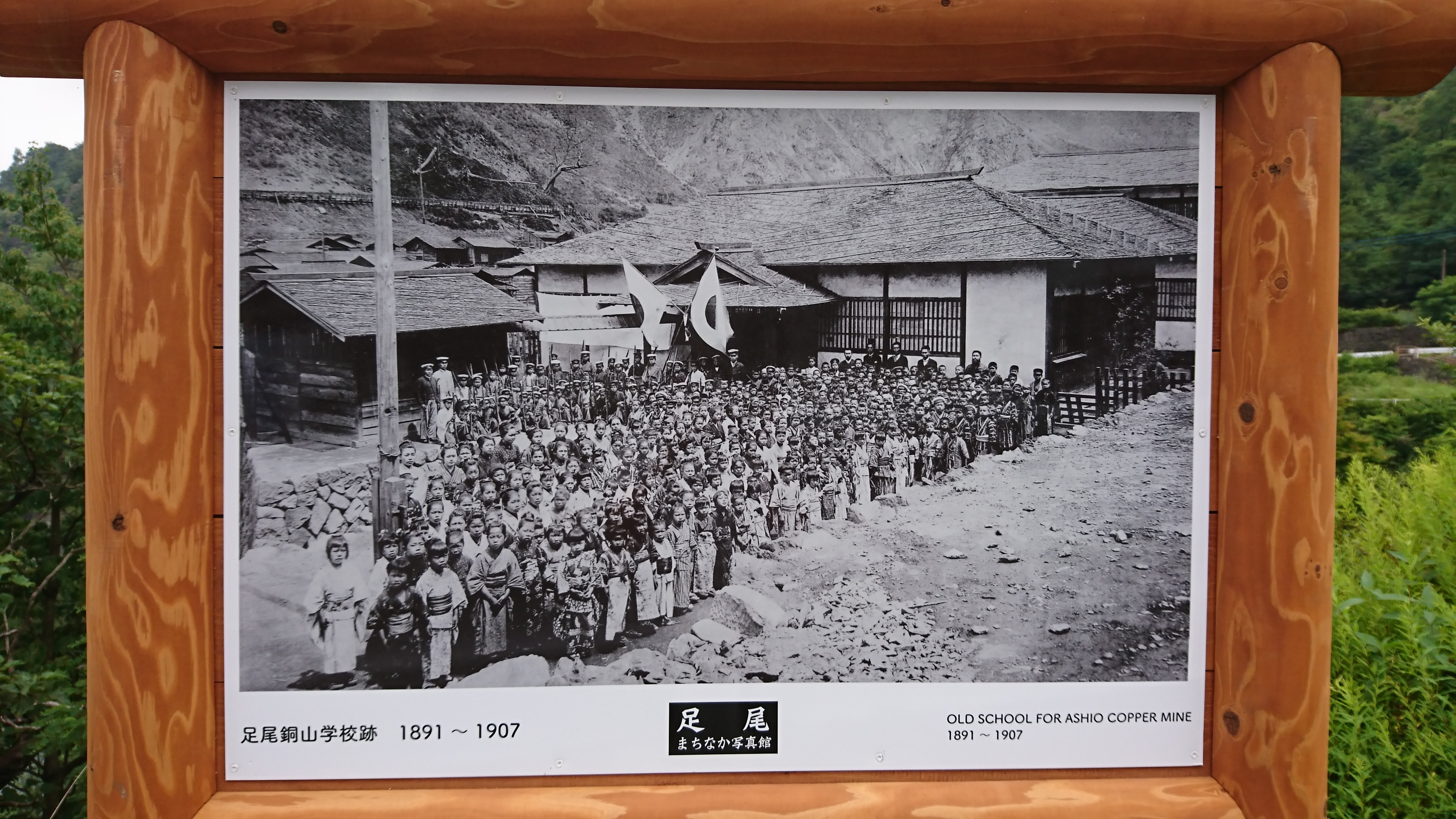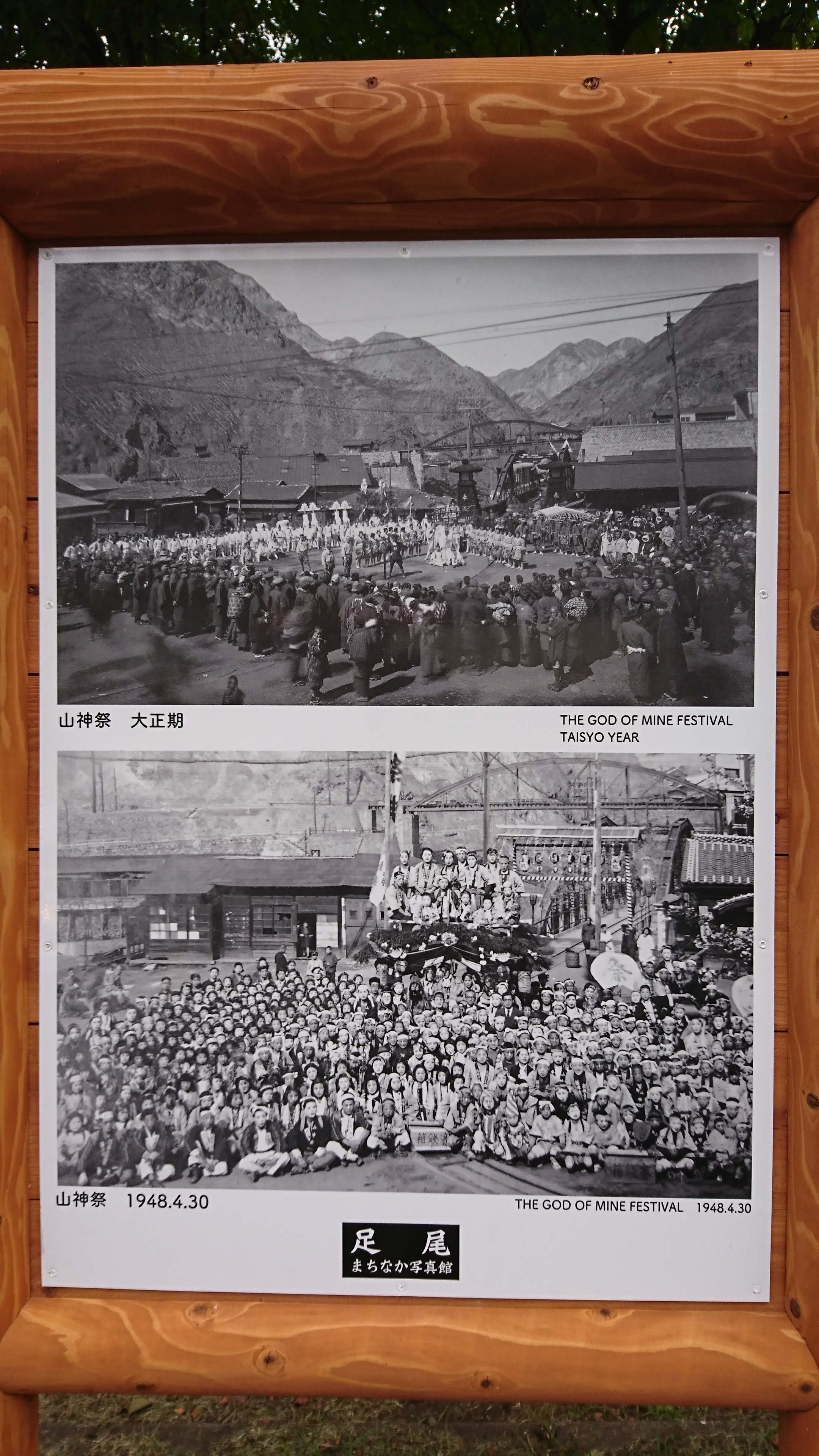産業遺産の見どころ
旧本山小学校 OLD HONZAN ELEMENTARY SCHOOL1907~2005

足尾の学校沿革史によると、明治6年8月本妙寺を仮用し足尾小学舎を開く・・・とあります。これが足尾で初めての学校であり、学制発布の翌年に当たります。また、明治6年10月には原に、明治8年12月神子内にそれぞれ分校が設立され、その後銅山の発展に伴い明治33年4月に独立校になりました。
足尾の教育の特色としては、銅山(古河鉱業・現古河機械金属株式会社)の経営する私立小学校が生まれたことであり、当時としては画期的なことでした。本山小学校の沿革史によると、明治16年頃、銅業事務整頓拡張せらることに従いこれが業務に従事するもの、子弟漸次増殖したるにより(中略)本山鷹之巣渡辺林之助の住宅に仮修繕を加え事務所の許可を得て校舎にあて・・・とあります。しかし、明治24年までは小学校令に基づいて足尾小学校の本山分校となっていました。明治25年7月6日、古河足尾尋常小学校として銅山経営の私立の小学校に改められ南橋に設立されました。その頃、赤倉に町立赤倉尋常小学校と上間藤に足尾小の分教場がありましたが、いずれも本山小学校に統合され明治40年1月に目の前の場所に移されました。明治26年2月18日に、本山学校の分校として小滝学校が許可され、その後独立しましたが、昭和29年に閉坑に伴い小滝の廃校となりました。
プールの他にスケート場も造られ、昭和15年には学校では珍しい講堂が造られました。
FORMER HONZAN ELEMENTARY SCHOOL
The history of Ashio’s school mention as below; Ashio Primary Education building will be established in August 1868 by temporarily using Honmyoji temple. This is Ashio's first school, and the year after the school system was promulgated. In addition, branch schools were established in Hara in October 1897 and in Mikouchi in December 1883, and then became independent schools in April 1958 with the development of the copper mine.
One of the characteristics of Ashio's education was the establishment of a private elementary school run by a copper mine (Furukawa Mining Co., Ltd., now Furukawa Machinery & Metals Co., Ltd.), which was revolutionary at that time. According to the history of Honzan Elementary School, around 1884, due to the expansion of the copper industry, people who engage in the work force are expanding their family. Temporary repairs are ought to be made to Rinnosuke Watanabe's house in Takanosu, Honzan, and with the permission of the office the buildings can be used as school buildings. However, until 1891, the building was only used as the Honzan branch school of Ashio Elementary School based on the elementary school ordinance. The school was established in Nankyo on July 6, 1890, as Furukawa Ashio Jinjo Elementary School, which was run as a private elementary school managed by a copper mine. Meanwhile, Akakura Jinjo Elementary Municipal School in Akakura and the branch schoolhouse of Ashio Elementary School in Kamimato were both integrated into Honzan Elementary School and moved to this current location in January 1890. Kodaki School was approved as a branch school of Honzan Elementary School on February 18, 1897, and became independent after, but it was closed in 1954 due to the closure of the mine.
At Honzan Elementrary School, a pool and a skating rink and a lecture hall were built on February 18, 1897, which was rare in schools around that time.
城崎座 SIROSAKIZA TEATER1917~1940 上間藤繁華街 THE ENTERTAINMENT SPOTS IN KAMIMATO1916

上間藤は、江戸時代に下間藤も合わせて間藤村と言われ、足尾郷14ヵ村の中にあり、足尾の草分けの倉沢、神山氏が住み始め農業を営んでから開けたようです。1875(明治8)年に間藤北部の深沢入口に栃本屋という旅館が営業を開始し、近代足尾銅山の発展と共に赤倉に次いで商業地として中央の道を挟んで商店が軒を連ねるようになりました。
明治20年の松木の大火で集落は全焼してしまいましたが、見事な復興を遂げ、栃本屋は三階建てに、山手には真宗本願寺派説教所、専念寺、日蓮宗大相寺、真宗大谷派林照寺など寺の急増は、人口の増加と経済的発展を意味するものでした。旅館は、栃本屋の向いに松本屋、水力発電所北側に暢和館、貸席興業場としてイロハ座、城崎座が出来ました。イロハ座と城崎座は芝居などの興業のほかに労働争議の集会施設でもありました。
SIROSAKIZA TEATER, THE ENTERTAINMENT SPOTS IN KAMIMATO
Kamimato was one of the 14 villages in Ashio Township and was called Mato Village in the Edo period (1603-1868), including Shimomato. With the development of the modern Ashio Copper Mine, the area became the second largest commercial district after Akakura, with a row of stores across the central road. The village was completely destroyed by the Great Matsugi Fire of 1887, but it made a splendid recovery, and Tochimotoya became a three-story building.
The rapid increase in the number of temples on the mountain side, including the Sermon Hall of the Honganji sect of Shinshu Buddhism, Kesshinji Temple, Daishoji Temple of Nichiren Buddhism, and Rinshoji Temple of the Otani sect of Shinshu Buddhism, meant an increase in population and economic development. Irohaza and Shirosakiza were established as places to stage plays and other entertainments, and also served as meeting places for labor disputes.
栃本屋 TOCHIMOTOYA HOTEL SECOND FLOOR1875~1889 THIRD FLOOR1891~1933

明治22年当時足尾には3階建ての建屋が3軒ありました。栃本屋はその1軒で明治8年に建てられました。
古河市兵衛は、明治10年に来山した際に栃本屋の一角を事務所として使用させてもらいシステムを構築していったそうです。明治20年の松木村の大火で間藤村まで燃えてしまったので22年に三階建てに再建すると、大正年間には中禅寺から半月峠を越えて足尾見学に来る修学旅行の団体客で盛況を見せていたようです。日光小品を書いた作家芥川龍之介も宿泊したかもしれません。
THE SECOND FLOOR (1875-1889) AND THIRD FLOOR (1891-1933) OF TOCHIMOTOYA
In 1889, Ashio had three of three-story buildings. Tochimotoya was one of them and was built in1875.
Furukawa Ichibei utilized a corner of the Tochimotoya as an office to design a system when he visited the area in 1890. In regard to the conflagration in Matsugi village, happened in 1890, which burned up to Matsugi village, Tochimotoya was reconstructed into a three-story building in 2010. The hotel was busy in the Taisho era with some group of students on a school trip who came to Ashio from Chuzenji Temple taking Hangetsu pass. Ryunosuke Akutagawa, the writer who wrote short essays of Nikko, has possibly stayed in the hotel.
足尾銅山学校跡 OLD SCHOOL FOR ASHIO COPPER MINE1891~1907

南橋は、製錬所と出川を隔てた対岸から南に広がる鉱業集落です。明治20年の松木の大火で直利橋が焼け落ちたことで古河橋の鉄橋が竣工するまでは、本山への主要道路でした。
明治24年に8棟の銅山長屋が建てられ、明治25年7月に古河足尾銅山尋常小学校が建てられ認可され開校しました。明治40年に向間藤に新校舎が建てられ移転するまで、本山地区の銅山従業員弟子の初等教育が行われたそうです。明治30年に新たに5棟の長屋が建てられ福長屋と名づけられました。南橋となったのは、昭和21年です。尋常高等小学校は、2000人規模の小学校だったようです。
THE RUINS OF ASHIO COPPER MINE SCHOOL 1891-1907
Nankyo is a mining village covers further south from bank across the refinery, crossing over the Degawa. The bridge used to be the main road connects to Honzan after Naori Bridge was destroyed by the great fire of Matsugi in 1890 and until the iron bridge of Furukawa Bridge was completed.
Eight copper mine tenement houses were built in 1884, Furukawa Ashio Copper Mine Jinjo Elementary School was built and approved in July 1902. It appears that the primary education for the new employees from the copper mine in Honzan area was carried out here until the new school building was built and relocated to Mukaifuji in 1890. Five new tenement houses were built in 1890 and named Fuku Nagaya, which was renamed as Nankyo in 1946. Jinjo Higher elementary school had about 2000 students.
山神祭 大正期&1948.4.30 THE GOD OF MINE FESTIVAL TAISHO YEAR&1948.4.30

偶然同じアングルで記念写真が撮られています。小野崎一徳写真帖では年代が特定されていませんが、背景に本山製錬所への古河鉄道貨物専用の鉄橋が写っているので、大正3年以降の大正期と予測されます。
山神祭の始まりは、明治22年に本山坑関係者で造営された本山鉱山神社の下で太鼓や三味線でお祭りを開いたことが、全山の安全祈願を込めて先頭に天狗、巫女さん、木遣り、拍子木、山車の引手、江戸囃子の楽しいリズム、山車の上部におかめとひょっとこの楽しい踊りへと発展して行きました。当時お祭りは4月29日が宵祭り・30日が本祭りで山車は鉱山神社から赤倉広場を往復しました。明治41年頃から天狗と巫女が先頭に付くようになりました。
本山坑へ主に入っていた北部地区の北光少年団は毎年お祭りの前に天狗のお面を古峯神社にて安全祈願をしてから祭りを挙行しておりました。
SANJIN FESTIVAL IN THE TAISHO ERA&1948.4.30
The commemorative photos were taken from the same angle. The age is not specified in the Onozaki Kazunori Photo Album. However, it can be predicted to be after 1914 with the iron bridge dedicated to Furukawa Railway for cargoes at Honzan Smelter being shown in the background.
Sanjin Festival started in 1887, when the festival was held with drums and shamisen under the Honzan Mine Shrine, which was built by the people involved in the Honzan mine. People prayed for the safety in every mountain, and Tengu (a legendary creature in Japan), a shrine maiden, people with clapping woods and the puller of floats formed a queue. With the fun rhythm of Edo Hayashi and Okame (a lady with a short nose and swollen round cheeks) and Hyottoco (a man with protruding lips and squinty eyes) dancing on the top of the float, they created entertaining dance at the festival. At that time, the pre-celebration happened on the 29th of April and the main celebration did on the following day. The floats made a round trip from the mine shrine to Akakura Square. After around 1891, Tengu and shrine maiden came to the forefront of the floats.
The Hokko Boy Scouts in the northern area, which was mainly based in the Honzan mine, run the festival every year after praying for safety at Furumine Shrine with their Tengu mask.


